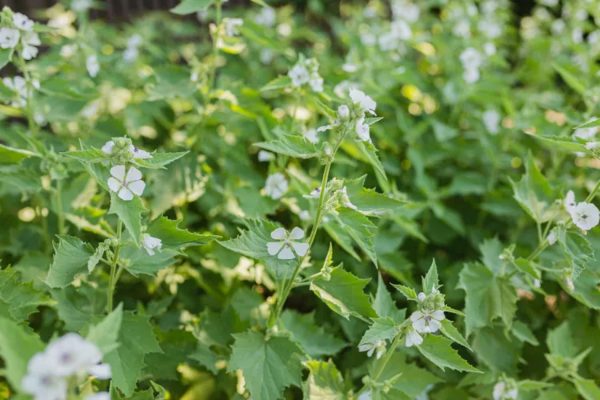The marshmallow plant is a tall perennial plant known for its flowers similar to hibiscus. The leaves and roots of this plant have mucilage, a substance that forms a thick gel when mixed with water. This plant also has medicinal values and the ancient Egyptians started the sweet treat that today we call marshmallows. The flowers are pollinators’ favorite. Brown seed pods start forming in late September and release small black seeds when mature.
Planting marsh mallow seeds depends on the climate; fall or spring.
Plant Attributes
- Common Name: Marsh mallow plant
- Scientific Name: Althaea officinalis
- Family: Malvaceae
- Mature Size: 3-6 ft. tall, 2.5 ft. wide
- Sun Exposure: Full
- Soil pH: Acidic, neutral, alkaline
- Soil Type: Moist
- Flower Color: White, Pink
- Bloom Time: Summer
- Hardiness Zone: 3-9 (USDA)
- Native Area: Europe, Asia
Marsh Mallow Plant Care
This plant is super easy to care for and a great option for wet, marsh-like areas. These are some of the requirements for growing a marsh mallow plant:
- Plant marsh mallow in a place where they get full sun and have moist or wet soil with proper drainage.
- The soil needs to be consistently moist and water accordingly.
- Add a 2-inch layer of mulch around the plants and keep the area of weeds until the plants are stable and tall enough.
- Fertilization is not required.
- Deadhead spent flowers and remove any dead leaves during the growing season.
Light
Marsh mallows love the full sun and do not thrive in the shade. While planting, make sure not to plant them in areas where taller plants will shadow over them.
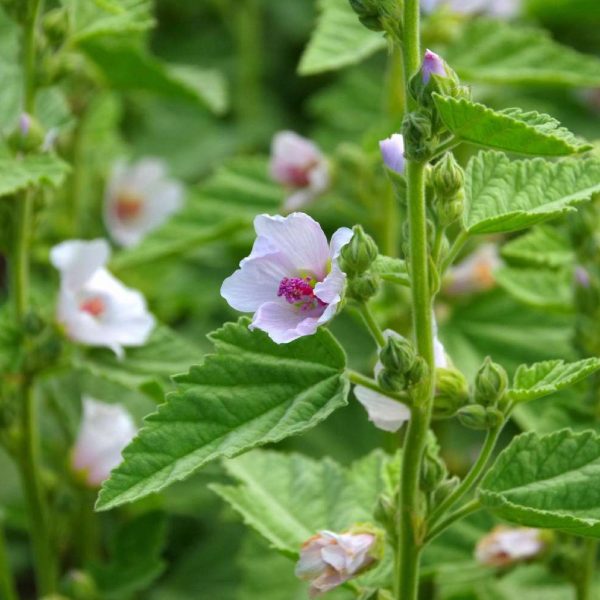
Soil
Just like its name, the marsh mallow like marshy and wet areas. A location with consistently damp soil and a slightly acidic pH of around 6.0 is perfect. Since these plants aren’t picky about soil pH levels, you don’t have to worry much about achieving acidic soil conditions.
Water
Marsh Mallows need consistent moisture with good drainage. If the soil is sandy, you can add moisture-retaining soil amendments like organic matter. Standing water is not recommended for the plants.
Temperature and Humidity
Marsh mallows are tough plants and survive in a variety of different climates and humidity levels. They can tolerate cold but during sub-freezing temperatures, they will die back and will emerge again in the spring. They do not have humidity likes or dislikes.
Fertilizer
Marsh mallow plants grow in different soils and can even tolerate soil that has a high saline content. So, applying any special kind of fertilizer isn’t necessary at all, especially if you have already added organic matter to the soil.
Pruning
It is not an absolute necessity to prune marsh mallow plants but improves the appearance of the plant to deadhead spent flowers and removes any dead leaves. This also makes the plant less inviting to pests.
Also, Read How to Grow and Care for Japanese Sedge!
How to Propagate Marsh Mallow Plants
Marsh Mallows can be propagated easily by root division:
- Let the plant go dormant in the late fall or early winter before the ground freezes.
- Dig up the plant with its entire root system.
- Using a sharp spade, divide the root mass into smaller parts.
- Replant the sections into a new suitable area at the same depth as the original plant.
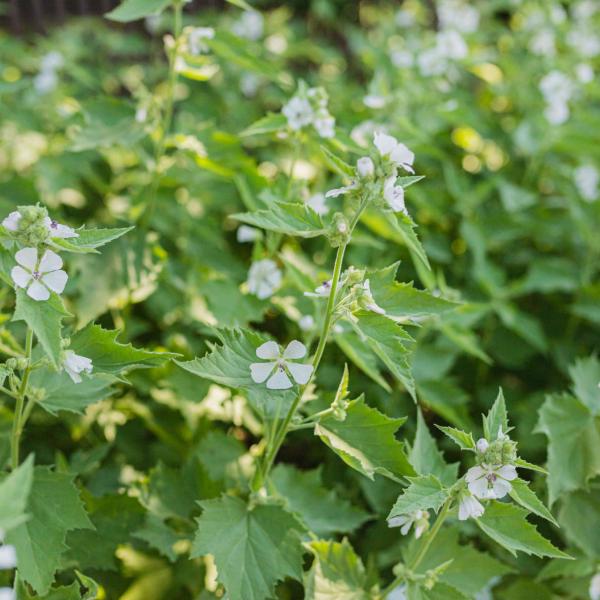
Propagation by division can be done in the early spring before the foliage starts to sprout because the plants die in the water. It could be quite a task to plant them before their winter dormancy breaks.
How to Grow Marsh Mallow Plants From Seeds
You can easily plant marsh mallows from seed, directly as well in the ground in the late fall if your area has mild winters or in the early spring if the winters are cold. These seeds germinate well if they go through eight to 12 weeks of cold stratification at 33 to 41 degrees F before planting.
- If you don’t plant the seeds in the fall (nature takes care of the stratification), keep the seeds in the refrigerator in a plastic bag with some lightly moistened peat moss.
- After the cold stratification period ends, start the seeds indoors three to four weeks before the last frost date, or sow them outdoors once the danger of frost has passed.
- Sow them in groups of five or six seeds spacing them 18 to 24 inches apart.
- Gently cover the seeds with soil and moisten them until they germinate which usually happens about three to four weeks.
- If you started the seeds indoors, transplant the seedlings outside in mid-to-late spring after hardening off.
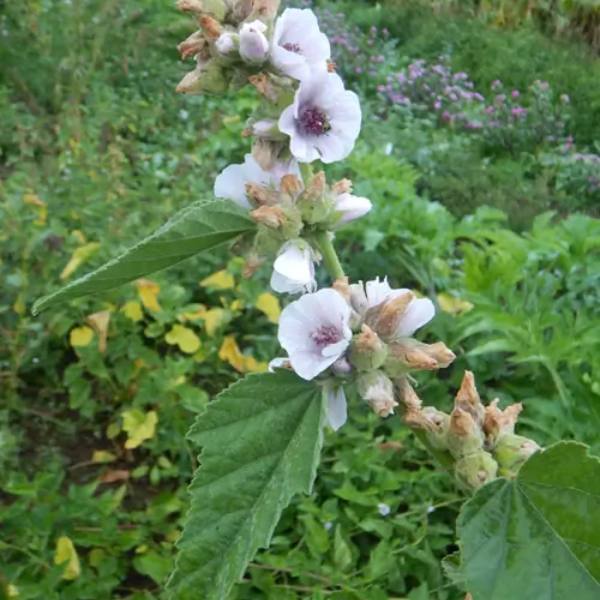
Potting and Repotting Marsh Mallow
We do not recommend growing marsh mallows in pots as they consistently need moist soil. It is difficult to maintain the moisture since the container plants dry out much faster than garden soil.
Common Pests and Plant Diseases
Despite every part of marsh mallow being edible, pests mostly leave this plant alone. One invader that could infest your marsh mallow is flea beetles which can lay eggs near the plants’ roots. The larvae feed on the roots first then the leaves, leaving holes on them. You can take care of the problem by applying neem oil.
While marsh mallows are resistant to diseases, they can still get rust, a fungal disease that emerges as raised white dots on the underside of leaves. The affected part turns orange, then yellowish-green and black. If this condition arrives, cut off the affected leaves and avoid overhead watering. If the case is severe, apply a copper-based fungicide designed to treat rust.
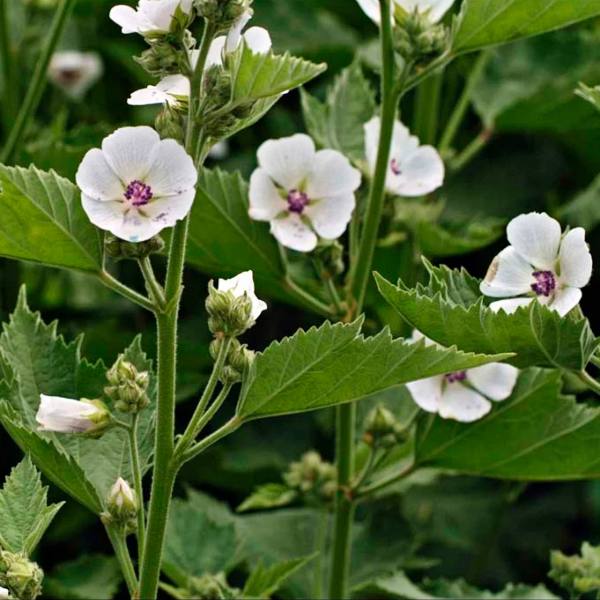
How to Get Marsh Mallow to Bloom
Bloom Months
They bloom from July to September.
How long does marsh mallow bloom?
Individual blooms do not last long but the plant bears flowers that live all summer long until fall.
What do marsh mallow flowers look and smell like?
While the flowers are pretty, they do not have fragrance. The tall, elegant spikes are covered with nearly white to blush or light pink flowers.
How to encourage more blooms?
If your marsh mallow plant is not blooming profusely, it could be because of the sun. Move it to a location where it gets full sun, six to eight hours per day. You can also prune nearby plants that cast shade on the marsh mallow to allow it to get more sunlight.
Caring for marsh mallow after bloom
Get rid of spent flowers and dead leaves to prevent the plants from attracting unwanted pests.
FAQs
Q: Does the mallow plant have anything to do with marshmallows?
A: Marshmallows were originally made by mixing mallow root sap, egg whites, and sugar to make the popular candy. In modern marshmallow production, the mallow root sap has been replaced by gelatin.
Q: How do I harvest marsh mallow roots?
A: Wait until the roots are large and mature, about two years old. Using a garden fork, dig them in the late fall or spring when the plant is dormant. Remove the roots you’ll need and replant the crown because the plant may continue to grow.
Q: Is marsh mallow plant invasive?
A: Marsh mallow plants reseed themselves, yet are not considered invasive. You might see them growing along a marshy roadside or in a meadow, and sometimes a volunteer will pop up in a home garden.
Also, Read Container Gardening Made Easy: 10 Sun and Shade-Loving Low-Maintenance Plants
